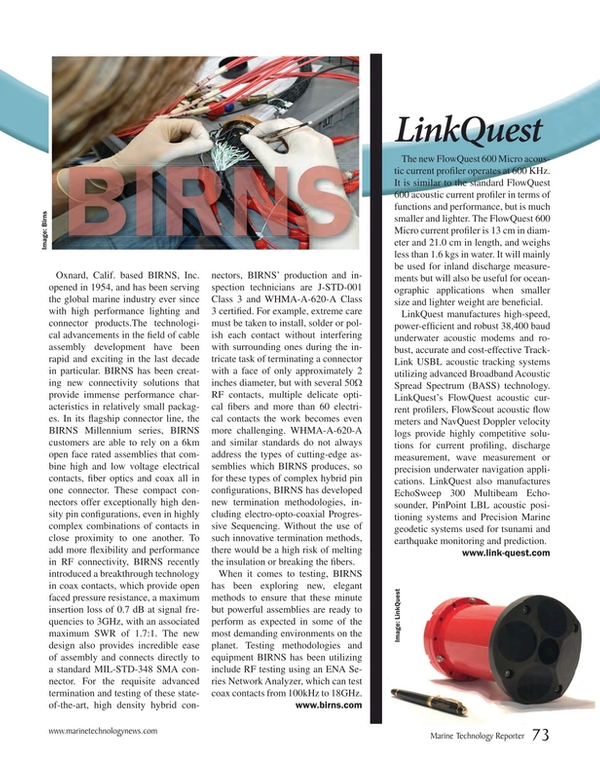
SoCal Tech Focus: BIRNS
Oxnard, Calif. based BIRNS, Inc. opened in 1954, and has been serving the global marine industry ever since with high performance lighting and connector products.The technological advancements in the field of cable assembly development have been rapid and exciting in the last decade in particular. BIRNS has been creating new connectivity solutions that provide immense performance characteristics in relatively small packages. In its flagship connector line, the BIRNS Millennium series, BIRNS customers are able to rely on a 6km open face rated assemblies that combine high and low voltage electrical contacts, fiber optics and coax all in one connector. These compact connectors offer exceptionally high density pin configurations, even in highly complex combinations of contacts in close proximity to one another. To add more flexibility and performance in RF connectivity, BIRNS recently introduced a breakthrough technology in coax contacts, which provide open faced pressure resistance, a maximum insertion loss of 0.7 dB at signal frequencies to 3GHz, with an associated maximum SWR of 1.7:1. The new design also provides incredible ease of assembly and connects directly to a standard MIL-STD-348 SMA connector. For the requisite advanced termination and testing of these state-of-the-art, high density hybrid connectors, BIRNS’ production and inspection technicians are J-STD-001 Class 3 and WHMA-A-620-A Class 3 certified. For example, extreme care must be taken to install, solder or polish each contact without interfering with surrounding ones during the intricate task of terminating a connector with a face of only approximately 2 inches diameter, but with several 50Ω RF contacts, multiple delicate optical fibers and more than 60 electrical contacts the work becomes even more challenging. WHMA-A-620-A and similar standards do not always address the types of cutting-edge assemblies which BIRNS produces, so for these types of complex hybrid pin configurations, BIRNS has developed new termination methodologies, including electro-opto-coaxial Progressive Sequencing. Without the use of such innovative termination methods, there would be a high risk of melting the insulation or breaking the fibers.
Read SoCal Tech Focus: BIRNS in Pdf, Flash or Html5 edition of March 2017 Marine Technology
Other stories from March 2017 issue
Content
- UUV Manufacturer Aims Big by Going Small page: 28
- Greensea: Redefining the Connection between Man and Machine page: 34
- Uncharted Depths: Exploring the Marianas with SuBastian page: 44
- Next-Generation Subsea Metrology: Better Measurements, Fast page: 52
- Interview: Margaret Leinen - Director, Scripps Institution of Oceanography page: 67
- Greg Cox: Growing the Blue Economy page: 70
- SoCal Tech Focus: BIRNS page: 73
- SoCal Tech Focus: LinkQuest page: 73
- SoCal Tech Focus: Blue Robotics page: 74
- SoCal Tech Focus: SIDUS Solutions page: 74
- SoCal Tech Focus: Planck Aerosystems page: 75
- SoCal Tech Focus: Global Ocean Design page: 75
- SoCal Tech Focus: DimEye page: 76
- SoCal Tech Focus: Tecnadyne page: 77


